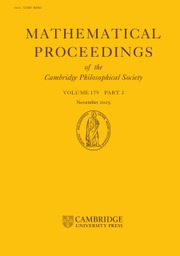Article contents
The Stokes phenomenon and generalized contiguous transformations of some generalized hypergeometric functions
Published online by Cambridge University Press: 24 October 2008
Abstract
Previous investigations by the author into the Stokes phenomenon pertaining to solutions of the differential equation dnu/dzn = (–1)nzmu are extended in order to find when different equations have the same set of Stokes multipliers, with perhaps a series of zeros being additionally allowed. The reason for periodic cycles to exist (with n fixed and m varying), with the same Stokes multipliers regained after a complete cycle, is traced to certain transformation properties of the equations. Within the first cycle (with n fixed and m varying) further remarkable identities exist between the Stokes multipliers, and this also is traced to special transformations between the equations. Relations are found toexist when values of m are chosen so that the highest common factors of the two integers n and n/(n + m) are identical. Finally, a transformation of the independent variable is deduced whereby the set of Stokes multipliers for an equation of order n is identical (apart from the additional zeros) to that for an equation of lower order. A hierarchy of equations is thrown up, whereby certain basic equations are transformed to yield more advanced equations of higher order and different m.
Information
- Type
- Research Article
- Information
- Mathematical Proceedings of the Cambridge Philosophical Society , Volume 76 , Issue 2 , September 1974 , pp. 423 - 442
- Copyright
- Copyright © Cambridge Philosophical Society 1974
References
REFERENCES
- 4
- Cited by

